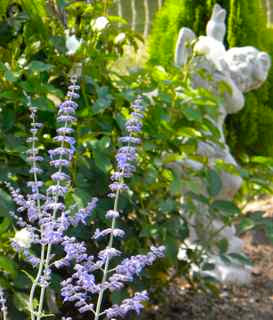Located near my home in the Pocono Mountains of Pennsylvania, Grey Towers National Historic Site is a wonderful mansion to visit at any time of the year, but today it is abloom with beautiful holiday decorations. The mansion was the home of Gifford Pinchot and his wife Cornelia. Gifford was the first Chief of the US Forest Service and two-terms PA governor. His father built Grey Towers, designed by Richard Morris Hunt, in the style of a medieval French chateau to reflect the French heritage of the family. The mansion was originally intended as a summer home and was completed in 1886. It is named for the towers on three corners of the L-shaped mansion.
As a gardener, I am very drawn to Gifford Pinchot, not only because of his magnificent 102 forested acres at Grey Towers, but because Gifford implemented the groundbreaking concept of conservation, or sustainable use of our national resources. Therefore, I was very honored to be asked to speak at this year's annual Gifford Pinchot Audubon Society's holiday tea held at the mansion. The society requested a program on 'sustainable gardening practices that attract pollinators in light of the bee decline' ... a subject very dear to my heart. I loved presenting this program in such a beautiful, and appropriate, setting.
Now, I have a confession to make. Although this wondrous place is little more than one hour from my home, this was my first visit! Oh, dear, why is it that we travel so very far to see the wonders of the world and miss those on our very doorstep? Now I cannot wait to return in the spring and summer to see the gardens in bloom. However, this first visit was very special as I toured the magnificent rooms, enjoyed the holiday decorations, ate delicious cookies and drank hot chocolate, and made new like-minded (as in gardening) friends!
This is my favorite Christmas tree in the mansion. It was decorated with home-made, beautifully crafted ornaments.
There are 15 fireplaces at Grey Towers. The most magnificent one is in the drawing room.
 |
| Drawing Room Fireplace |
 |
| Drawing Room Painting |
I think many of you who know me will understand why the library is my favorite room at Grey Towers. Like all the other rooms, it was very tastefully decorated. One thing I like about the holiday decorations at Grey Towers is that they are not 'over the top'.
 |
| Library Fireplace |
 |
| The Library |
 |
| Gifford Pichot's Bedroom |
 |
| View from a second floor window |
 |
| A casual mix of winter evergreens. |
 |
| The Finger Bowl: Outdoor Dining Room. |
 |
| The Tinderbox. A playhouse built for Gifford and Cornelius' s son. |
The little courtyard in front of the playhouse has elliptical windows affording wonderful views. The one below frames Grey Towers' most popular tree, the European copper beech. Gifford planted nine of them in the 1920's.
 |
| European Copper Beech Fagus sylvatica 'Atropurpurea' |
I am so happy I visited Grey Towers at last. I am grateful to Lori McKean of the USDA Forest Service for coordinating my visit. Thank you, Lori. It won't be my last!
I am hoping to do another posting before Christmas, but in case I don't get to it, I wish all my wonderful garden blogging friends Peace, Joy and Love this holiday season!
Pamela x
 |
| Woodcarving of Grey Towers by W. Dauer, US Forest Service |
~~ I love reading your comments. I hope you leave one so I’ll know you visited!
I look forward to visiting your blog in return.
























































